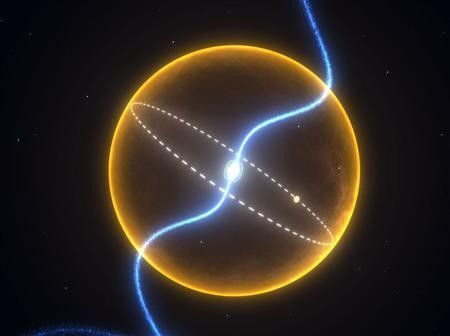New Diamond, the Size of a Planet, Found

In an exciting discovery, researchers have found an exotic planet made completely of diamond, orbiting an even more exotic star relatively close to Earth.
The new planet is more dense than anything observed before, and is made almost entirely of carbon. Because the molecules are so tightly packed together, researchers calculate that it must be crystalline in nature, making it effectively diamond.
The study was led by Professor Matthew Bailes of Swinburne University of Technology in Australia and published in the journal Science.
The evolutionary history and amazing density of the planet all suggest it is comprised of carbon -- i.e., a massive diamond orbiting a neutron star every two hours in an orbit so tight it would fit inside our own Sun, said Bailes.
The team first detected an unusual pulsating star, called a pulsar, lying some 4,000 light years away. Pulsars are tiny, dead neutron stars that are only about 12 miles in diameter and spin hundreds of times a second, emitting beams of radiation.
Astronomers said only two of the 1,800 known pulsars concealed planets and it's the first diamond planet ever seen.
In the case of this pulsar -- named called PSR J1719-1438 -- irregular movements in the beams clued scientists in that there was a companion planet orbiting the pulsar, tipping them off to the existance of the diamond planet.
Researchers said the planet, which orbits its star every two hours and 10 minutes, has slightly more mass than Jupiter but is 20 times as dense, Bailes and colleagues reported in the journal Science on Thursday.
In addition to carbon, the new planet is also likely to contain oxygen, but the density suggests that the lighter elements of hydrogen and helium, which are the main constituents of gas giants like Jupiter, aren't present.
While all the findings suggests the planet to be a massive diamond, precisely what it looks like up close is still a mystery.
In terms of what it would look like, I don't know I could even speculate, said Ben Stappers of the University of Manchester. I don't imagine that a picture of a very shiny object is what we're looking at here.
It's highly speculative, but if you shine a light on it, I can't see any reason why it wouldn't sparkle like a diamond, Travis Metcalfe of the National Center for Atmospheric Research told New Scientist.
The team comprised of scientists from Australia, Germany, Italy, the UK and the U.S. made the discovery by using a 64-meter radio telescope in Parkes, Australia.
© Copyright IBTimes 2024. All rights reserved.




















